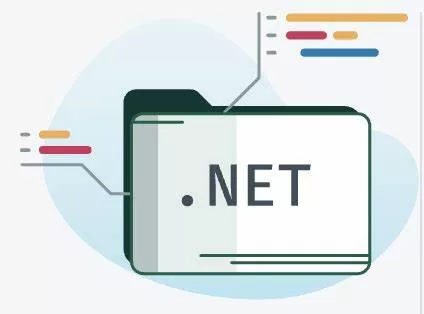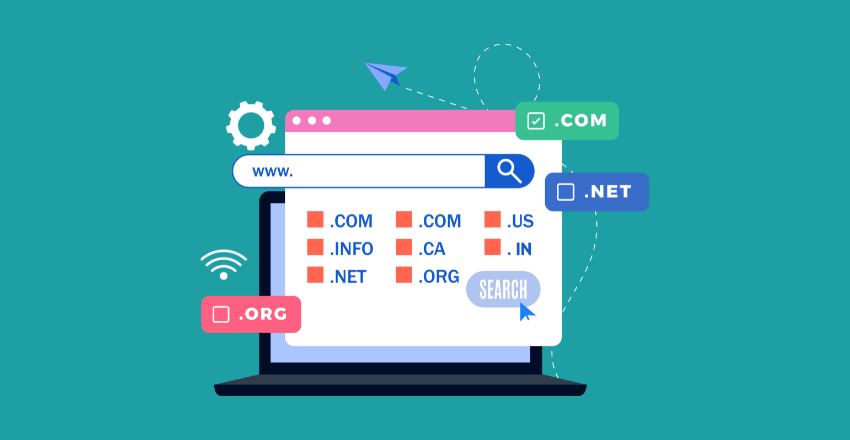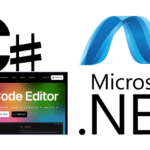“Ever scratched your head and asked, ‘why is .Net is called dot net‘ Don’t worry, you’re not alone. As a .NET developer, I’ll demystify this intriguing question today.

Strap in and prepare to explore the vibrant world of .NET with me.
Background and Context
Since bursting onto the scene in 2002, .NET has revolutionized the programming world. This brainchild of Microsoft aimed to support a host of technologies, but why the distinctive name? The “dot” or “.” in “.NET” has sparked curiosity aplenty.
Let’s uncover the seven intriguing reasons that answer, “Why dot net is called dot net?”
1. Diving into .NET’s “Internet Orientation”
As a seasoned .NET developer, I’ve often marveled at how the framework has embraced the Internet since its inception.
The “Internet Orientation” of .NET isn’t merely a naming convention—it’s a testament to the framework’s capabilities and its foresight in recognizing the transformative role of the Internet in technology.
Let’s expand on this intriguing concept with examples, pro tips, and a dash of code.
.NET Framework and the Web: A Match Made in Code Heaven
When we speak of “.NET’s Internet Orientation,” we’re referring to its inherent ability to create powerful web applications, services, and APIs. At its core, .NET was built with a deep understanding of the internet’s architecture and how to optimally use it.
This orientation is evident in two major features:
- Web Services: .NET supports the creation of web services, which are methods of communication between two electronic devices over a network. A prime example of this is the ASMX web services technology that Microsoft introduced with .NET.
// Example of a basic ASMX web service in .NET using System.Web.Services; [WebService(Namespace = "http://example.com/MyWebService")] public class MyWebService : WebService { [WebMethod] public string HelloWorld() { return "Hello World"; } }In this simple code snippet, we’ve created a web service that returns “Hello World”. It’s a basic demonstration, but it underscores the ease with which .NET facilitates the development of web services.
- ASP.NET: ASP.NET is a powerful framework for building dynamic websites, applications, and services. It is part of the broader .NET framework, providing a robust suite of tools and libraries tailored for web development.
// A simple ASP.NET MVC controller using System.Web.Mvc; public class HomeController : Controller { public ActionResult Index() { ViewBag.Message = "Welcome to ASP.NET!"; return View(); } }In this example, we’ve created a simple controller in an ASP.NET MVC application. This controller renders the “Index” view with a welcome message—a quintessential task in web development.
Pro Tips from the Trenches
Having worked with .NET, I’ve picked up a few handy tips that leverage .NET’s “Internet Orientation”:
- Embrace the Rich Ecosystem: ASP.NET provides several project templates like MVC, Web Forms, and Web Pages. Try out these different models to understand their strengths and choose the best fit for your project.
- Leverage Web APIs: ASP.NET Web API is a powerful framework for building HTTP services. Use it to create RESTful APIs that can be consumed by a wide range of clients—from web to desktop and mobile.
- Master Entity Framework: Entity Framework is an object-relational mapper (ORM) that enables .NET developers to work with relational data using domain-specific objects. It reduces the amount of code you need to write when dealing with databases—crucial in web development.
.NET’s “Internet Orientation” isn’t just a nod to the domain names of the internet era; it’s an inherent design principle. From facilitating the creation of web services to building dynamic web applications, .NET was built to harness the power of the web, and it does so exceptionally well.
2. Shedding Light on .NET’s “Network Enabled Technologies”
Throughout my journey as a .NET developer, I have witnessed the transformative power of the framework’s “Network Enabled Technologies”. .NET embraces networking and cloud computing, enabling developers to create scalable applications that excel in a networked environment.
This philosophy is deeply integrated into .NET’s DNA. With a comprehensive suite of tools and libraries, .NET makes network-oriented application development a breeze.
Networked Application Development with .NET: The Basics
To illustrate how .NET is designed with “Network Enabled Technologies” in mind, consider the following features:
- Web Services and RESTful APIs: Web services and APIs form the backbone of networked applications, allowing different software systems to communicate and exchange data. As mentioned before, .NET provides extensive support for creating web services. Additionally, it also offers ASP.NET Web API for building RESTful services.Here’s a simple example of a Web API controller that handles HTTP requests:
// A simple Web API controller using System.Web.Http; public class ValuesController : ApiController { // GET api/values public IEnumerable<string> Get() { return new string[] { "value1", "value2" }; } }This controller exposes an HTTP GET endpoint that returns an array of string values, demonstrating the ease of setting up network communication using .NET.
- SignalR: SignalR is a library that simplifies real-time web functionality in applications. Real-time web functionality enables server-side code to push content updates to connected clients instantly.Below is an example of setting up a SignalR hub:
// A simple SignalR hub using Microsoft.AspNet.SignalR; public class ChatHub : Hub { public void SendMessage(string name, string message) { Clients.All.broadcastMessage(name, message); } }This code snippet creates a “ChatHub” that can broadcast messages to all connected clients, showcasing .NET’s support for real-time networking functionality.
Pro Tips for Navigating the Networked Landscape
Over the years, I’ve picked up some valuable tips when developing networked applications in .NET:
- Prioritize Security: Always enforce strong security practices when dealing with network communications. The .NET framework provides a host of security measures like authentication, encryption, and data integrity tools—make the most of them.
- Embrace Asynchrony: Network communications can be slow, and you don’t want your application hanging while waiting for a response. .NET offers excellent support for asynchronous programming. Understand and use the async and await keywords to improve your application’s responsiveness.
- Leverage Cloud Capabilities: Consider harnessing the power of cloud services like Azure. With its robust integration with .NET, you can easily build, deploy, and scale applications.
The “Network Enabled Technologies” aspect of .NET isn’t just about the name—it’s a defining characteristic of the framework that underlines its prowess in handling network communications with ease.
It’s one of the many reasons why .NET continues to be a preferred choice for developers worldwide. Now, you are armed with the understanding of what this part of .NET’s name truly represents and how to best take advantage of it in your own projects.
3 .NET’s “Interoperability” – A Key to Versatile Coding

In my odyssey as a .NET developer, the framework’s “Interoperability” has repeatedly proven to be one of its most powerful traits. .NET is designed to foster seamless cooperation between different programming languages and software components.
In other words, .NET’s interoperability facilitates the interaction of diverse systems, bridging the gap between different languages and platforms.
.NET’s Interoperability Unveiled
When we delve into .NET’s “Interoperability,” we encounter two key features:
- Language Interoperability (CLI): One of .NET’s most remarkable features is its Common Language Infrastructure (CLI). CLI allows developers to use multiple programming languages for different components within the same application. For instance, you might write one part of a .NET application in C#, another part in Visual Basic.NET, and yet another in F#.
Here’s a basic example of a C# class and a VB.NET class, both of which can be used interchangeably in a .NET application:
// C# Class
public class CSharpClass
{
public string SayHello()
{
return "Hello from C#!";
}
}
' VB.NET Class
Public Class VBNetClass
Public Function SayHello() As String
Return "Hello from VB.NET!"
End Function
End ClassDespite the different programming languages, both classes serve the same purpose in a .NET application, showcasing .NET’s language interoperability.
- Platform Invoke (PInvoke): .NET also allows developers to call native functions present in DLLs, facilitating interaction with the underlying operating system. This is made possible by Platform Invocation Services (PInvoke), which provides a bridge between managed and unmanaged code.
Here’s an example of using PInvoke to call the MessageBox function from the user32.dll:
// Calling a native function using PInvoke using System.Runtime.InteropServices; public class Program { [DllImport("user32.dll", CharSet = CharSet.Unicode)] public static extern int MessageBox(IntPtr hWnd, string text, string caption, uint type); static void Main() { MessageBox(new IntPtr(0), "Hello, World!", "Test", 0); } }This code calls a native function to display a message box—a clear demonstration of .NET’s capability to interoperate with native code.
Pro Tips for Harnessing .NET’s Interoperability
Based on my personal experience, here are some pro tips to make the most of .NET’s interoperability:
- Choose the Right Language: Each language has its strengths. C# might be excellent for system-level programming, while F# shines in data analysis. Leverage .NET’s language interoperability to use the right language for the task at hand.
- Ensure Proper Error Handling: When dealing with PInvoke, ensure proper error handling. Native function calls might not throw exceptions like managed code, so always check the return values and use the
Marshal.GetLastWin32Errormethod if necessary. - Mind Performance Costs: Although PInvoke is powerful, it comes with a performance cost. Only use it when necessary, and avoid in performance-critical paths.
The “Interoperability” embedded in .NET’s name is a testament to its remarkable ability to harmonize diverse languages and software components. As developers, we are granted the freedom to choose from a myriad of languages and the power to interact directly with native functions—all under the .NET umbrella.
This is one of the main reasons why .NET continues to be a staple in the programming world. So, keep exploring and make the most of this amazing framework’s capabilities.
4. “.NET’s Dot Notation” – A Programmer’s Perspective

Navigating through as a .NET developer, I’ve always found solace in the familiarity and structure provided by the .NET” notation.
It’s more than just a snappy name – the dot notation reflects one of the fundamental aspects of programming languages that .NET excels in – accessing members of a class or an object.
This might seem trivial, but its significance resonates with the very core of object-oriented programming.
Dots Everywhere: Member Access in .NET
When we discuss “.NET’s Dot Notation,” we’re referring to how we use dots in programming languages, specifically in .NET-supported languages such as C#, VB.NET, and F#, to access methods, properties, or fields of a class or an object. It’s fundamental to the way we structure and interact with our code.
Consider the following C# example:
// Defining a class with properties public class DotNetClass { public string Property1 { get; set; } public int Property2 { get; set; } } // Accessing class properties using dot notation DotNetClass instance = new DotNetClass(); instance.Property1 = "Hello, .NET!"; instance.Property2 = 15;In this example, we’ve defined a class DotNetClass with two properties: Property1 and Property2.
We then create an instance of this class and use dot notation to access and assign values to these properties.
Pro Tips for Mastering Dot Notation
Here are some pro tips that can enhance your mastery of dot notation:
- Understand Null Value Risks: Be cautious when chaining member access operations. If one element in the chain returns null, it will throw a NullReferenceException. Starting from C# 6.0, you can use the null-conditional operator (
?.) to safely access members and avoid this issue. - Use Fluent APIs: A lot of libraries in .NET use fluent APIs, which allow chaining of method calls. It’s a powerful way to write more readable and expressive code.
- Know Your Scope: Member accessibility (public, private, protected, etc.) determines what you can access using dot notation. Understanding these scopes can help prevent access violations.
The “Dot Notation” in “.NET” isn’t just for show—it’s a nod to a fundamental concept in programming that is prevalent throughout the .NET framework.
As a developer, your journey with .NET equips you to appreciate this simple notation and wield it efficiently in writing structured, maintainable code.
So, remember, every time you type that dot, you’re part of a tradition that resonates with the core of object-oriented programming. That’s the beauty and significance of “.NET”.
5. Marketing Strategy
To distinguish .NET from Java by Sun Microsystems—its main competitor at the time—Microsoft used the “dot” as an innovative naming approach, giving .NET a unique flair and a memorable presence in the market.
6. Domain Name Reference

People often use “dot net” for the .net domain name, the second most popular domain name after .com. With “.NET,” Microsoft aimed to build upon this familiarity and create an immediate association with the internet.
7. Metaphorical Significance
The “dot” might also be a metaphor for “connection” or “networking”. Thus, “.NET” embodies the framework’s mission of seamlessly connecting applications, services, and devices.
Practical Example
Let me illustrate how .NET showcases interoperability with this simple example:
// C# code public class Hello { public string SayHello() { return "Hello, World!"; } } // VB.NET code Public Class HelloVB Public Function SayHello() As String Return "Hello, World!" End Function End ClassThough written in two different languages (C# and VB.NET), both classes perform the same function, thanks to the language interoperability of .NET.
Conclusion
In a nutshell, “.NET” is not just a name—it’s a symbol that represents the framework’s capabilities, the vision it stands for, and the era it emerged from. Now you know why dot net is called dot net and the ingenious thinking that went into naming this versatile development platform.
The next time you hear “.NET,” you’ll remember the rich context and meaning hidden within these three characters.
Eager to explore more about .NET? Don’t hesitate to dive deeper and share your insights or questions in the comments below.

Jessica is a highly accomplished technical author specializing in scientific computer science. With an illustrious career as a developer and program manager at Accenture and Boston Consulting Group, she has made significant contributions to the successful execution of complex projects.
Jessica’s academic journey led her to CalTech University, where she pursued a degree in Computer Science. At CalTech, she acquired a solid foundation in computer systems, algorithms, and software engineering principles. This rigorous education has equipped her with the analytical prowess to tackle complex challenges and the creative mindset to drive innovation.
As a technical author, Jessica remains committed to staying at the forefront of technological advancements and contributing to the scientific computer science community. Her expertise in .NET C# development, coupled with her experience as a developer and program manager, positions her as a trusted resource for those seeking guidance and best practices. With each publication, Jessica strives to empower readers, spark innovation, and drive the progress of scientific computer science.







